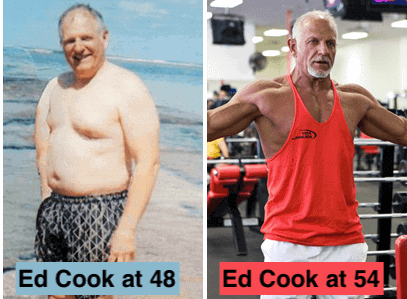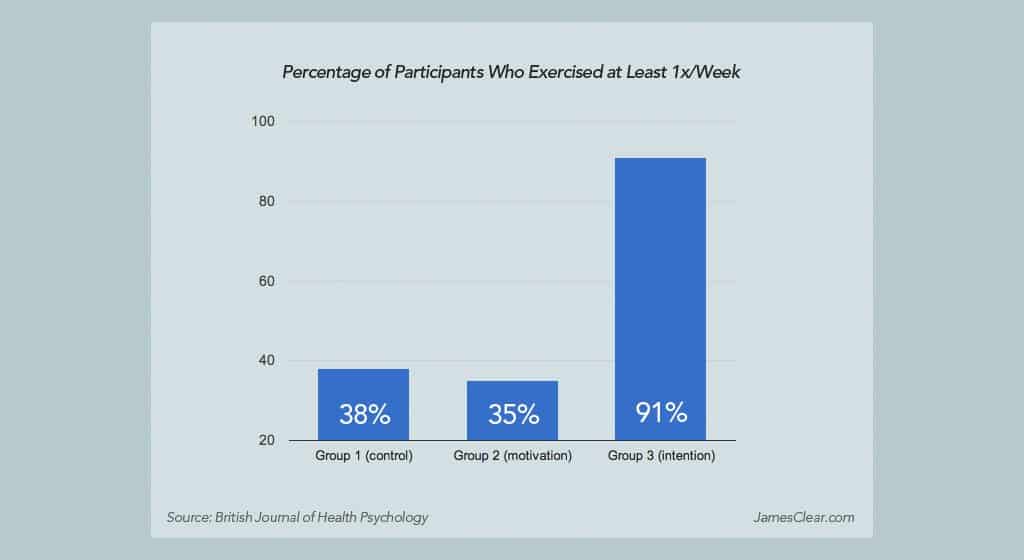Double Your Success With These Three Habit-making Experts
Double your success rate by getting inspired, cultivating desire and then translating your intention into a doable plan. Let these 3 experts show you how… (P.S. Motivation is largely irrelevant.)
A NEW YEAR is about to unfold, a time even when the most pessimistic of us get a “can-do” surge of optimism as we head down to our local gym and plop down our credit card.
“This year’s gonna be different!”
After a few decades on the planet, you begin to see a trend. Much of those promises we made to ourselves were broken; ignored actually.
The good news it that, despite past sins, the promise of a New Year gets us to get up, dust off the dirt and look to begin anew.
The bad news is that this optimistic spirit fades quickly, and we revert to old, ingrained attitudes and habits that guide our life experience.
It’s time to do things differently.
In this article, you’ll discover:
- How a 53 year-old became “Superman”;
- How to double your success in achieving your goals;
- A 12-step habit change roadmap; and
- How to break old habits and the negative self-talk that’s holding you back.
Let’s dig in…
Get Jacked by the Inspirational “Superman”
As we get older, sometimes life feels too overwhelming, and you feel you don’t have enough time to right the wrongs.
That’s why you need to watch and listen to Ed.
Ed Cook turned his life around, and unless your as numb as a frostbit toe, his story will inspire you to do the same.
In Ed’s case, how he decided to redo his life was through bodybuilding, but don’t get turned off should this sorta thing not be your thing. He used bodybuilding as his vehicle to turnaround an overweight and sick body, but what’s important about his message is that it’s never too late, and you’re never too low to get up and do something great.
Ed makes the important point that material things pale in comparison to the robustness of your spirit. Discover what you need to do to invigorate your spirit and whatever it is, write it down and create a plan to get it done.
I’ll be speaking more to plans in a bit, but first, to Ed:
You can learn more about Ed Cook on his BodySpace page.
Now that your mind is in the right place, let’s learn how to double your chance for success by reading what James has to say.
How To Double Your Success Rate
Ed’s got you fired up. Now let James (and later, Matt) direct all that energy into getting done what you want done.
Habit-making expert James Clear says that you don’t need motivation to achieve your goals. In fact, he says, motivation “is exactly what you don’t need”.
Instead of motivation, what’s needed to achieve your goals are habits. He cites a study published in the British Journal of Health Psychology, where researchers measured how frequently people exercised over a two-week period.
The researchers started by randomly assigning 248 adults to one of three groups.
Group 1 was the control group. They tracked exercise frequency over the two-week period, after which each person read the opening three paragraphs of a novel.
Group 2 was the motivation group. They also tracked exercise frequency for two weeks, after which each read a pamphlet on the benefits of exercise for reducing the risk of heart disease. Participants in Group 2 were also told, “Most young adults who have stuck to a regular exercise program have found it to be very effective in reducing their chances of developing coronary heart disease.”
Group 3 was the intention group. After being told to track their exercise, they also read the motivational pamphlet and got the same speech as Group 2. The objective was to ensure that Group 2 and Group 3 were equally motivated. The goal for both Group 2 and 3 was to exercise regularly.
There was, however, an important difference between Groups 2 and 3.
Unlike Group 2, those in Group 3, were also asked to formulate a plan for when and where they would exercise over the following week. Each participant in Group 3 was specifically asked to explicitly state his/her intention to exercise by completing the following statement:
During the next week, I will partake in at least 20 minutes of vigorous exercise on [DAY] at [TIME OF DAY] at/in [PLACE].
After receiving these instructions, all three groups went on their merry way.
Here’s what happened…
The Difference between Motivation and Intention
After two weeks the researchers checked with the individuals of each of the three Groups. This bar graph shows their findings:
As you can clearly discern from the bar graph above:
- In the Control Group, 38% of participants exercised at least once per week.
- In the Motivation Group, 35% of participants exercised at least once per week.
- In the Intention Group, an incredible 91% of participants exercised at least once per week.
Conclusion:
Simply by writing down a plan that detailed exactly when and where they intended to exercise, the participants in Group 3 were much more likely to actually convert intention into action.
So, what does this indicate about motivation versus intention?
Note that the Motivation Group (Group 2) performed essentially the same as the Control Group (Group 1).
The researchers concluded that:
- Motivation had no significant effects on exercise behavior; and
- Although desire is necessary to effect change, it needs to inspire a plan that you will implement.
As the saying goes,
“Plan your work and work the plan.”
Matt Frazier has a 12-step plan for you to consider. (Actually, he calls it a “roadmap”.)
Try This 12 Step Habit Change Roadmap
Matt Frazier is the mastermind behind the widely popular No Meat Athlete website. He just released his New Year’s Habit Change Kit, which will surely double your success.
I’m going to quickly summarize it for you, but encourage you to read the whole thing.
Matt knows of what he speaks – the lad taught himself to be a bountiful vegan and to run 50-mile races. Along the way, he’s written a few books.
Here’s the essence of Mr. Frazier’s 12 Step Habit Change Roadmap:
- Choose your habit and pick a start date.
- Determine the smallest step you could take each day as you form your habit, and commit to doing only that.
- Set an end date.
- Select a trigger activity. (This is really clever… and it works!)
- Place a visual reminder (or several) near where you’ll be when your trigger activity occurs.
- Create accountability. (Use the “buddy system” – recruit a friend to bludgeon you if you don’t follow the plan.)
- Engineer the habit environment.
- Plan ahead for any obstacles.
- Start! Do your habit each day, if the particular habit allows.
- Each day, record your success or failure and report to your accountability partner(s).
- Each week, review what’s working right, what’s not working, and what you can do differently going forward.
- When you’re ready, increase the amount you do each day.
Of course, the value of these 12 steps to create sustainable habits to get what you want out of your life is in the details, which you’ll have to read Matt’s magnus opus to get. You’ll also get 5 tips to help you succeed.
But is all this enough?
I mean, despite the finely tuned advice given by James Clear and Matt Frazier – as well as the inspiration provided by Ed Cook – it could be that you’re just too embedded in the muck and mire of a lifetime of bad habits and negative self-talk to get anything aspirational to happen.
It could be that the voices in your head are sabotaging you.
What if your bad habits prevent good ones from sprouting and taking hold?
Your Bad Habits Are Simply Three Different Selves
This idea comes from Eric Barker, who in his blog post, This Is How To Quit Bad Habits Without Willpower: 3 Secrets From Neuroscience, writes:
… here’s the good news: you’re not lazy, you’re not a screw up, and you’re not a bad person. In fact, you don’t actually have “bad habits” at all. Those tempting or nagging voices in your head aren’t evil. Actually, they’re trying to help you.
Mr. Barker then introduces psychological theorems from Internal Family Systems Skills Training Manual and Self-Therapy, which personify the different aspects (personas) of our selves by naming them by their dominant attribute and how “they” primarily attempt to influence you:
- Exiles have deep-seated fears,
- Mangers try to ensure the fears don’t get triggered, but when they do,
- Firefighters put out the fire.
In this context, you don’t have “bad habits”, only different selves with different goals in your head — all trying to do what they think is best for the greater “you.”
The problem is they’re not always right about what’s best and the goals of the “Fireman” might be in conflict with the “Manager”.
From Self-Therapy:
Parts [the different aspects of you] are entities of their own, with their own feelings, beliefs, motivations, and memories. It is especially important to understand that parts have motivations for everything they do. Nothing is just done out of habit. Nothing is just a pattern of thinking or behavior you learned. Everything (except for purely physiological reactions) is done by a part for a reason, even though that reason may be unconscious.
Given this, you can you procrastinate and feel guilty about it at the same time. It’s the different aspects of you disagreeing.
“Part of you is afraid of being a loser and wants to accomplish things. The other part of you is afraid of being all stressed out and wants to watch Netflix and eat popcorn”, says Barker.
In this situation, you need to understand what each part of you is trying to accomplish, and find a better way to address the underlying need so you can both get on the same page.
The Tug-of-War Between Exiles, Managers and Firefighters
I’ve already touched on these aspects of ourselves. Now let’s dig deeper into the interplay between our Exiles, Managers and Firefighters.
Exiles
This is name some therapists give to personify your deep, dark fears and long-held negative beliefs.
Somewhere along the line, we’ve all wrestled with this self-talk:
- “I’m stupid”
- “I’m a failure”
- “I’m unlovable”
- “I can’t trust anyone”
This is the stuff emanating from the proverbial “inner child” to whom bad stuff happens. The emotions and fears connected to that bad stuff lingers and wind up influencing our behavior in maddening ways.
Exiles need a good, soothing talking to.
Managers
We’d be in trouble if the Exiles were left to whimper all by their lonesome in some corner. Thankfully, our inner child has an overprotective parent, the Manager.
You know the Manger by the nagging voice in your head that admonishes you to work harder, that you’re being weak and need to do more.
From Internal Family Systems Skills Training Manual:
We call proactive parts “managers” because they try to manage our lives in ways that keep emotional pain out of consciousness. They often focus on motivating us to improve, work hard, be productive and be socially acceptable. At the extreme, however, these aims can devolve into tactics like perfectionism, intellectualizing, one-sided caretaking, obsessing about appearance, conflict avoidance at great personal cost and trying to control or please others.
Managers are useful, needed even, despite their annoying voice. Thankfully, when overbearing, Firefighters come to the rescue.
Firefighters
When Exiles are spinning down into some vortex of despair and Mangers are relentlessly, but ineffectively, shouting for them to pull themselves up by their bootstraps, Firefighters can save the day.
From Internal Family Systems Skills Training Manual:
[Firefighters] share the same goal as managers; they want to exile vulnerable parts and extinguish emotional pain. However, [firefighters] are emergency response workers. They get activated after the fact, when the memories and emotions of Exiles break through despite the repressive efforts of managers. [Firefighters] tend to be fierce and use extreme measures that Managers abhor, like alcohol and drug abuse, binge eating, excessive shopping, promiscuity, cutting, suicide and even homicide.
Yes, it appears to be a dysfunctional family, these three aspects of our person hood, but like most families, they’re here to stay, so the smart thing to do is to give them all a voice and try to blend them together harmoniously.
Eric Barker suggests that you do these three things to create harmony:
1) Get calm
Sit down, be still, and breathe.
Think about the primary “bad habit” or issue at hand.
Are the voices in your head compelling you to…
- Push too hard?
- Slack off and procrastinate?
- Judging that you’re not smart or beautiful enough?
- Telling you not to trust people?
These voices are aspects of yourself and they need a talking to.
2) Talk to yourself
Yes, you’re going to talk to yourself like you have multiple personalities, because in this construct you do.
Research shows talking to yourself can make you smarter, improve your memory, help you focus and even increase athletic performance.
Strangely, talking to yourself in the second person (saying “you” instead of “I”) makes a difference:
Altogether, the current research showed that second-person self-talk strengthens both actual behavior performance and prospective behavioral intentions more than first-person self-talk.
Don’t argue with yourself. Accept and acknowledge what you “hear”.
3) Talk To The Exile
Touch base with your inner child and accept what it feels.
Stay calm. Be gentle. And listen. Perhaps it’s saying something like this, Mr. Barker suggests:
I’m afraid of failing. Doing the work makes me think about it not turning out well. And then I’ll be a loser and no one will like me.
You want to start addressing these underlying concerns. Fix them and the bad habits take care of themselves. Assure the Exile and the Manager that you’re going to work on this. You’ll make a plan and be accountable to it. Recruit a friend to help.
All this self-talk and personifications may seem ridiculous, but it gives you a systematic approach to potentially figure out and unwind whatever it is that’s holding you back.
Your Takeaway
Now that you know how to “double your success”, to what will you apply these techniques? Kate Forsyth over at Be Healthy has some suggestions in her post, 7 New Year’s Resolution You Should Have for 2018, including one of my favorites, “exercise your brain”. Go check it out… but before you do…
Remember these four things:
- You can do better, just as Ed Cook did, but you need enough desire to make a plan and work it.
- Will power is like a muscle — it wears out, and motivation can wane as well. What you need is desire, intention and that plan I keep mentioning.
- Regarding that plan… make one… Matt Frazier provided us a roadmap that can double your success.
- If you feel sabotaged by your own bad habits and negative self-talk, identify from which aspect of yourself the chatter is coming from (Exile, Manager or Firefighter) and get them aligned.
Like what James, Matt and Eric have to say? Have at it:
Last Updated on February 7, 2024 by Joe Garma











